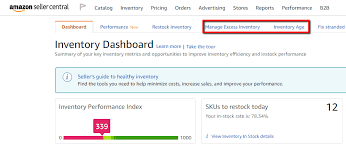Amazon is one of the world’s largest e-commerce and technology companies, offering a wide range of products and services globally. It operates as an online marketplace where third-party sellers and businesses can list their products alongside Amazon’s own inventory.
Amazon is a global e-commerce leader that relies on efficient inventory management to make sure smooth operations for both sellers and customers. To help sellers optimize their stock levels, Amazon uses the Inventory Performance Index (IPI), a key metric that measures how well sellers manage their inventory in Fulfillment by Amazon (FBA).
By maintain a good IPI score, sellers can increase their sales performances, reduce costs, and improve product visibility on Amazon marketplace.
In this article we’ll discuss about Inventory Performance Index (IPI) in-depth, and how it effect you sales and also will guide you to improve your IPI score.

What is Amazon Inventory Performance Index (IPI)?
The Amazon Inventory Performance Index is a lead metric that is designed to support sellers track overall inventory performance. The IPI score ranges from 0 to 1000, with a higher score indicating good inventory management. It is influenced by factors such as:
A low IPI score can lead to storage restrictions and increased fees, while a high score helps sellers maximize storage space, decrease costs, and increase product availability. Maintaining a strong IPI score ensure a smooth supply chain, better sales performance, and enhanced visibility on Amazon platform.
Sellers can improve their Inventory Performance Index score by managing stock efficiently, decreasing slow-moving inventory, and keeping best-selling product in stock, make Suring extending success in the marketplace.
When is the Amazon Inventory Performance Index Score updated?

The Amazon IPI score is updated “weekly”, typically on “Monday”. Amazon continuously tracks inventory performance and adjusts the score based on recent sales, stock levels, and fulfillment efficiently.
Since the score is updates weekly, sellers have a opportunity to build up their inventory performance index through optimizing inventory management before the next update. Maintaining a high IPI Score is important to avoid “storage limits and additional fees”, make sure smooth operations within “Fulfillment by Amazon (FBA)”.
Sellers should regularly monitor their IPI dashboard, address excess inventory, fix stranded stock, and improve sell-through rates to keep their score in a healthy range.
What is a Good Inventory Performance Index Score on Amazon?

A good Amazon IPI score typically falls at or above “400”. Amazon uses this score to evaluate how well sellers manage their inventory in Fulfillment by Amazon (FBA). A score of 400 or higher is considered healthy and support sellers avoid storage limits, long-term storage fees, and inventory restrictions. On the other hand, a score below 400 may leaf to limited storage space during the next storage cycle and higher costs for excess or aged inventory.
To maintain or improve your Inventory Performance Index score, focus on key factors such as reducing excess inventory, improving sell-trough rates, keeping popular in stock, and fixing stranded inventory. A higher IPI score not only offers better storage flexibility but also contributes to smoother business operations, lower fees, and increased sales opportunities on Amazon.
What is the Factors that influence your Amazon Inventory Performance Index Score?
Several factors influence your Amazon Inventory Performance Index (IPI) score, which plays a key role in managing your inventory health and ensuring smooth operations within Fulfillment by Amazon (FBA).
Here are the primary factors that impact your Inventory Performance Index Score:
1. Excess Inventory

Excess inventory refers to stock that has been sitting in Amazon fulfillment centers for a long time without sufficient sales. Holding too much inventory can lower your IPI score and lead to higher long-term storage fees. Sellers should regularly review their:
- Inventory Age Report
- Run promotions
- Adjust pricing to reduce excess stock and improve their stock
2. Sell-Through Rate

3. Stranded Inventory

4. In-Stock Rate for Popular Products

Amazon rewards sellers who keep their best selling products consistently in stock, Running out of stock frequently impacts both your sales and IPI score. Analyzing the restock Inventory Report and maintaining good stock levels for high-demand items can prevent stockouts and improve your score.
By addressing these key factors, sellers can increase their Inventory Performance Index score, avoid storage limits and extra fees, and create a more profitable and efficient inventory management strategy on Amazon.
How to Enhance your Amazon IPI Score?
The Amazon Inventory Performance Index (IPI) score is crucial for sellers using Fulfillment by Amazon (FBA), as it determines storage limits, extra fees, and overall inventory efficiency. A higher IPI Score means better inventory management, while a low score can lead to storage restrictions and higher costs.
Below are the key strategies to increase and maintain a strong IPI score:
1. Decrease Excess Inventory
Decreasing excess inventory is crucial for maintain a healthy Amazon Inventory Performance Index (IPI) score and avoiding unnecessary storage fees.
Excess inventory refers to products stored in Amazon fulfillment centers for over 90 days without sufficient sales.
Holding too much stock can lower your IPI score and increase long-term storage costs, affecting profitability.
To reduce excess inventory, sellers can implement strategies like offering discounts, running promotions, adjusting pricing, or bundling products to increase sales velocity.
Moreover, sellers can use Amazon Lightning Deals, Coupons, and PPC advertising to attract more buyers. However, certain products continue to remain unsold, using Amazon FBA Liquidations program or removing slow-moving stock can support free up storage space. Regularly monitoring the “Inventory Age Report” an keeping a balanced sock level ensures better inventory management, improving sell-through rates and general sales performance on Amazon.
2. Inventory Management
Improving your sell-through rate is crucial for maintain a high Amazon IPI score and ensuring efficient inventory management. The sell-through rate is calculated by dividing the number of unites sold over the past 90 days by the total units stored in Amazon fulfillment centers. A low sell-through rate indicates slow-moving inventory, which can lead to storage restrictions and increased fees.
Sellers should focus o optimizing product listings with high-quality images, engaging descriptions, and relevant keywords to attract more buyers. Running Amazon PPC ads, and offering discount can also enhance sales.
3. Maintain Inventory Balance
Maintaining inventory balance is essential for optimizing your Amazon IPI score. A well-balanced inventory means having enough stock to meet demand without overstocking or understocking.
Overstocking can be enhance storage fees, while understocking results in lost sales and customer dissatisfaction.
To get the right balance, sellers should use Amazon “FBA Inventory Dashboard” and Restock Reports” to monitor stock levels and forecast demand based on historical sales data.
Implementing “Just-in-time inventory management” helps prevent excess stock while make sure famous products remain available.
4. Avoiding Overstocking
Overstocking occurs when sellers store more inventory than needed, which can lead to slow-moving stock, higher “long-term storage fees”, and lower “sell-trough rare”. To prevent overstocking, sellers should monitor sales trends through:
- Use Amazon “Restock Suggestions”.
- Leverage inventory forecasting tools.
- Sellers should orders only what is necessary based on demand.
- Promotions, Adjusting pricing and offering discounts can also support of sellers to clear excess stock and improve inventory flow.
By maintain the right balance of inventory, sellers can increase their sell-through rate, avoid storage restrictions, and improve overall efficiency, leading to better performance and profitability on Amazon.
(Note: Monitoring the FBA Inventory Dashboard and Inventory Age Report permit sellers to identify slowly selling products and take timely action)
5. Boost Your IN-Stock Rate
The in-stock rate measures hoe effectively you keep your best selling products available on Amazon. Running out of stock not only affects your Inventory Performance Index score but can also result in lost sales, reduced visibility, and lower customer satisfaction.
To Boost your in-stock rate, you should follow the below instructions:
- Sellers should regularly analyze Amazon stock by “Restock Inventory Repot” which provides recommendations on when and how much stock to reorder based on sales data.
- Setting up alerts for low stock levels can help prevent stockouts.
- Accurate demand predicting is also important to use historical sales trends, seasonal data, and product performance insights to plan inventory replenishment effectively.
- Keeping a healthy in-stock rate make sure that customers can ever find your product, leading to “better inventory health, enhances revenue, and a stronger position in Amazon marketplace”.
Conclusion
The Amazon Inventory Performance INDEX (IPI) score is a crucial metric that measures how efficiently sellers manage their inventory in Fulfillment by Amazon (FBA). A higher IPI score (typically 400 or above) indicates healthy inventory management, helping sellers avid storage limits, additional fees, and other restrictions.
Increasing Amazon IPI sore instantly, focus on decreasing slow-moving or excess stock, boosting sales velocity through optimizing product listings and running promotions, keeping best-selling products in stock, and fixing stranded inventory issues promptly.
By using Amazon Inventory Age Report, Restock Report, and FBA Inventory Dashboard can help you analyze stock levels and plan more effectively. Through keeping up a balanced inventory and addressing these factors consistently, you can increase your IPI score, improve profitability, reduce storage costs, and ensure long-term success on Amazon marketplace.





